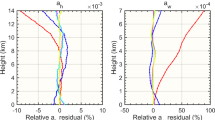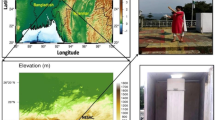Abstract
Polarization lidar observations were made to study the transport of an elevated aerosol layer over Gadanki, India (13.45° N, 79.17° E) during the pre-monsoon period of the year 2009. Observations show significant aerosol layering within and above the boundary layer. Coordinated observations with radiosondes were carried out from 2 to 10 April 2009. Temporal and spatial variations of the parameters are studied for the boundary layer (≈ 2.5 km) and up to 5 km. The backscattering coefficient and the depolarization ratio are observed to increase and decrease with an increase in humidity, respectively. Clouds are not formed, indicating less efficiency of the aerosol in acting as condensation nuclei. The transport of the elevated aerosol layer is investigated using a back-trajectory analysis, revealing that the transported layer originating from the central Indian region has a depolarization ratio of at least 0.05. From model analysis and satellite fire-count data, it is inferred that the source of the aerosol layer is wildfire events over the central Indian region. The elevated smoke-aerosol layer (not mixing with the boundary layer) has implications for the altering of the temperature profile of the atmosphere and the suppression of cloud formation.











Similar content being viewed by others
References
Badarinath KVS, Kharol SK, Kaskaoutis DG, Sharma AR, RamaswamyV KambezidisHD (2010) Long-range transport of dust aerosols over the Arabian Sea and Indian region—A case study using satellite data and ground-based measurements. Glob Planet Change 72:164–181
Basha G, Ratnam MV (2009) Identification of atmospheric boundary layer height over a tropical station using high-resolution radiosonde refractivity profiles: comparison with GPS radio occupation measurements. J Geophys Res Atmos. https://doi.org/10.1029/2008JD011692
Chan KM, Wood R (2013) The seasonal cycle of planetary boundary layer depth determined using COSMIC radio occultation data. J Geophys Res Atmos. https://doi.org/10.1002/2013JD020147
Fadnavis S, Sabin TP, Roy C, Rowlinson M, Rap A, Vernier J-P, Sioris CE (2019) Elevated aerosol layer over South Asia worsens the Indian droughts. Sci Rep 9:10268. https://doi.org/10.1038/s41598-019-46704-9
Fernald FG (1984) Analysis of atmospheric lidar observations: some comments. Appl Opt 23:652–653. https://doi.org/10.1364/AO.23.000652
Flamant C, Pelon J, Flamant PH, Durand P (1997) Lidar determination of the entrainment zone thickness at the top of the unstable marine atmospheric boundary layer. Boundary-Layer Meteorol 83:247–284. https://doi.org/10.1023/A:1000258318944
Giglio L, Descloitres J, Justice CO, Kaufman YJ (2003) An enhanced contextual fire detection algorithm for MODIS. Remote Sens Environ 87:273–282. https://doi.org/10.1016/S0034-4257(03)00184-6
Hegg D, Larson T, Yuen PF (1993) A theoretical study of the effect of relative humidity on light scattering by tropospheric aerosols. J Geophys Res Atmos 98:18435–18439
Kaimal JC, Abshire NL, Chadwick RB, Decker MT, Hooke WH, Kropfli RA, Neff WD, Pasqualuccim F (1982) Estimating the depth of the daytime convective boundary layer. J Appl Meteorol 21:1123–1129
Klett JD (1981) Stable analytical inversion solution for processing lidar returns. Appl Opt 20:211–220. https://doi.org/10.1364/AO.20.000211
Kovalev VA, Eichinger WE (2004) Elastic lidar: theory, practice, and analysis methods. Wiley, Hoboken
Krishna Moorthy K, Nair PR, Krishna Murthy BV, Satheesh SK (1996) Time evolution of the optical effects and aerosol characteristics of Mt. Pinatubo origin from ground-based observations. J Atmos Terr Phys 58:1101–1116
Krishnamurti TN, Jha B, Prospero J, Jayaraman A, Ramanathan V (1998) Aerosol and pollutant transport and their impact on radiative forcing over the tropical Indian Ocean during the January–February 1996 pre-INDOEX cruise. Tellus Ser B Chem Phys Meteorol 50:521–542. https://doi.org/10.1034/j.1600-0889.1998.00009.x
Kumar YB (2016) Lidar research activities and observations at NARL site. In: Proceedings of Spie–Lidar remote sensing for environmental monitoring XV, New Delhi, India 12.2227291
Li Z, Lau WKM, Ramanathan V, Wu G, Ding Y, Manoj MG, Liu J, Qian Y, Li J, Zhou T, Fan J, Rosenfeld D, Ming Y, Wang Y, Huang J, Wang B, Xu X, Lee SS, Cribb M, Zhang F, Yang X, Zhao C, Takemura T, Wang K, Xia X, Yin Y, Zhang H, Guo J, Zhai PM, Sugimoto N, Babu SS, Brasseur GP (2016) Aerosol and monsoon climate interactions over Asia. Rev Geophys 54:866–929. https://doi.org/10.1002/2015RG000500
Martucci G, Matthey R, Mitev V, Richner H (2007) Lidar determination of the frequency of variations of the boundary-layer top. In: International geoscience and remote sensing symposium (IGARSS). pp 2767–2770
Menut L, Flamant C, Pelon J, Flamant PH (1999) Urban boundary layer height determination from lidar measurements over the Paris area. Appl Opt 38:945–954. https://doi.org/10.1364/AO.38.000945
Mishra MK, Rajeev K, Thampi BV, Parameswaran K, Nair AKM (2010) Micropulse lidar observations of mineral dust layer in the lower troposphere over the southwest coast of Peninsular India during the Asian summer monsoon season. J Atmos Solar-Terr Phys 72:1251–1259. https://doi.org/10.1016/j.jastp.2010.08.012
Murayama T, Furushima M, Oda A, Iwasaka N (1996) Depolarization ratio measurement in the atmospheric boundary layer by lidar in Tokyo. J Meteorol Soc Jpn 74:571–578
Murayama T, Okamoto H, Kaneyasu N, Kamataki H, Miura K (1999) Application of lidar depolarization measurement in the atmospheric boundary layer: effects of dust and sea-salt particles. J Geophys Res 104:31781. https://doi.org/10.1029/1999JD900503
Murayama T, Müller D, Wada K, Shimizu A, Sekiguchi M, Tsukamoto T (2004) Characterization of Asian dust and Siberian smoke with multi-wavelength Raman lidar over Tokyo, Japan in spring 2003. Geophys Res Lett 31:1–5. https://doi.org/10.1029/2004GL021105
Nishizawa T, Sugimoto N, Matsui I, Shimizu A, Liu X, Zhang Y, Li R, Liu J (2010) Vertical distribution of water-soluble, sea salt, and dust aerosols in the planetary boundary layer estimated from two-wavelength backscatter and one-wavelength polarization lidar measurements in Guangzhou and Beijing, China. Atmos Res 96:602–611. https://doi.org/10.1016/j.atmosres.2010.02.002
Pal S, Haeffelin M, Batchvarova E (2013) Exploring a geophysical process-based attribution technique for the determination of the atmospheric boundary layer depth using aerosol lidar and near-surface meteorological measurements. J Geophys Res Atmos 118:9277–9295. https://doi.org/10.1002/jgrd.50710
Patel AK, Kumar YB, Vishnu R, Murti MVR, James Jebaseelan Samuel E (2017) Dual polarization lidar for remote sensing of aerosols and clouds in the atmosphere. Curr Sci 113:1134–1138
Rajeev K, Ramanathan V (2001) Direct observations of clear-sky aerosol radiative forcing from space during the Indian Ocean Experiment. J Geophys Res 106:17221. https://doi.org/10.1029/2000JD900723
Rajeev K, Ramanathan V, Meywerk J (2000) Regional aerosol distribution and its long-range transport over the Indian Ocean. J Geophys Res 105:2029. https://doi.org/10.1029/1999JD900414
Rajeev K, Parameswaran K, Thampi BV, Mishra MK, Nair AKM, Meenu S (2010) Altitude distribution of aerosols over Southeast Arabian Sea coast during pre-monsoon season: elevated layers, long-range transport and atmospheric radiative heating. Atmos Environ. https://doi.org/10.1016/j.atmosenv.2010.04.014
Ramanathan V (2001) Aerosols, climate, and the hydrological cycle. Science 294:2119–2124. https://doi.org/10.1126/science.1064034
Reid JS, Prins EM, Westphal DL, Schmidt CC, Richardson KA, Christopher SA, Eck TF, Reid EA, Curtis CA, Hoffman JP (2004) Real-time monitoring of South American smoke particle emissions and transport using a coupled remote sensing/box-model approach. Geophys Res Lett. https://doi.org/10.1029/2003gl018845
Sahu LK, Sheel V, Pandey K, Yadav R, Saxena P, Gunthe S (2015) Regional biomass burning trends in India: analysis of satellite fire data. J Earth Syst Sci 124:1377–1387. https://doi.org/10.1007/s12040-015-0616
Sakai T, Shibata T (1997) Relative humidity, backscattering ratio and depolarization as derived from Raman Lidar observations. J Meteorol Soc Jpn 75:1179–1185
Sassen K (2003) Polarization in lidar: a review. Polariz Sci Remote Sens 5158:151–160. https://doi.org/10.1117/12.507006
Satheesh SK, Krishna Moorthy K (2005) Radiative effects of natural aerosols: a review. Atmos Environ 39:2089–2110
Satheesh SK, Krishna Moorthy K, Suresh Babu S, Vinoj V, Dutt CBS (2008) Climate implications of large warming by elevated aerosol over India. Geophys Res Lett. https://doi.org/10.1029/2008GL034944
Seidel DJ, Ao CO, Li K (2010) Estimating climatological planetary boundary layer heights from radiosonde observations: comparison of methods and uncertainty analysis. J Geophys Res Atmos. https://doi.org/10.1029/2009JD013680
Sicard M, Pérez C, Rocadenbosch F, Baldasano JM, García-Vizcaino D (2006) Mixed-layer depth determination in the Barcelona coastal area from regular lidar measurements: methods, results and limitations. Boundary-Layer Meteorol 119:135–157. https://doi.org/10.1007/s10546-005-9005-9
Sokolovskiy S, Kuo YH, Rocken C, Schreiner WS, Hunt D, Anthes RA (2006) Monitoring the atmospheric boundary layer by GPS radio occultation signals recorded in the open-loop mode. Geophys Res Lett. https://doi.org/10.1029/2006GL025955
Streets DG, Yarber KF, Woo J-H, Carmichael GR (2003) Biomass burning in Asia: annual and seasonal estimates and atmospheric emissions. Glob Biogeochem Cycles 17:1099. https://doi.org/10.1029/2003GB002040
Sugimoto N, Shimizu A, Matsui I, Dong X, Zhao S, Zhou J, Lee C-H, Uno I (2005) Observations of Asian dust and air-pollution aerosols using a network of ground-based Mie-scattering lidars (invited paper). Proc SPIE-Int Soc Opt Eng 5832:131–139. https://doi.org/10.1117/12.619520
Venkataraman C, Habib G, Kadamba D, Shrivastava M, Leon JF, Crouzille B, Boucher O, Streets DG (2006) Emissions from open biomass burning in India: integrating the inventory approach with high-resolution moderate resolution imaging spectroradiometer (MODIS) active-fire and land cover data. Glob Biogeochem Cycles. https://doi.org/10.1029/2005GB002547
Vishnu R (2018) Lidar remote sensing of atmospheric boundary layer and its characterization. Dissertation, VIT University, Vellore, India http://hdl.handle.net/10603/211304
Vishnu R, Kumar YB, Sinha PR, Rao TN, James Jebaseelan Samuel E, Kumar P (2017) Comparison of mixing layer heights determined using LiDAR, radiosonde, and numerical weather prediction model at a rural site in southern India. Int J Remote Sens 38:6366–6385
Weitkamp C (2005) Lidar: range-resolved optical remote sensing of the atmosphere. Springer, New York
Westphal DL, Husar RB, McClure SE, Campbell JR, Hyer EJ, Reid JS, Sessions WR, Zhang J (2012) Global analyses and forecasts of aerosol impacts on visibility. In: Air and waste management association—aerosol and atmospheric optics: visibility and air pollution specialty conference 2012
Witek ML, Flatau PJ, Teixeira J, Markowicz KM (2011) Numerical investigation of sea salt aerosol size bin partitioning in global transport models: implications for mass budget and optical depth. Aerosol Sci Technol 45:401–414. https://doi.org/10.1080/02786826.2010.541957
Yadav S, Chauhan MS, Sharma A (2007) Characterisation of bio-aerosols during dust storm period in N-NW India. Atmos Environ 41:6063–6073. https://doi.org/10.1016/j.atmosenv.2007.03.050
Yorks JE, McGill M, Rodier S, Vaughan M, Hu Y, Hlavka D (2009) Radiative effects of African dust and smoke observed from Clouds and the Earth’s Radiant Energy System (CERES) and Cloud-Aerosol Lidar with Orthogonal Polarization (CALIOP) data. J Geophys Res Atmos. https://doi.org/10.1029/2009JD012000
Zhang J, Reid JS, Westphal DL, Baker NL, Hyer EJ (2008) A system for operational aerosol optical depth data assimilation over global oceans. J Geophys Res Atmos. https://doi.org/10.1029/2007JD009065
Acknowledgements
This research was supported by the National Atmospheric Research Laboratory, Department of Space, Government of India. The MODIS fire count data were obtained from https://firms.modaps.eosdis.nasa.gov/active_fire/, the NAAPS model analysis data from http://www.nrlmry.navy.mil/aerosol/, and the back-trajectory data from https://ready.arl.noaa.gov/HYSPLIT.php. The authors thanks to the two anonymous reviewers, whose comments and creative criticism helped improve the manuscript.
Author information
Authors and Affiliations
Corresponding author
Additional information
Publisher's Note
Springer Nature remains neutral with regard to jurisdictional claims in published maps and institutional affiliations.
Rights and permissions
About this article
Cite this article
Vishnu, R., Kumar, Y.B. & Nair, A.K.M. An Investigation of the Elevated Aerosol Layer Using a Polarization Lidar Over a Tropical Rural Site in India. Boundary-Layer Meteorol 178, 323–340 (2021). https://doi.org/10.1007/s10546-020-00573-2
Received:
Accepted:
Published:
Issue Date:
DOI: https://doi.org/10.1007/s10546-020-00573-2




